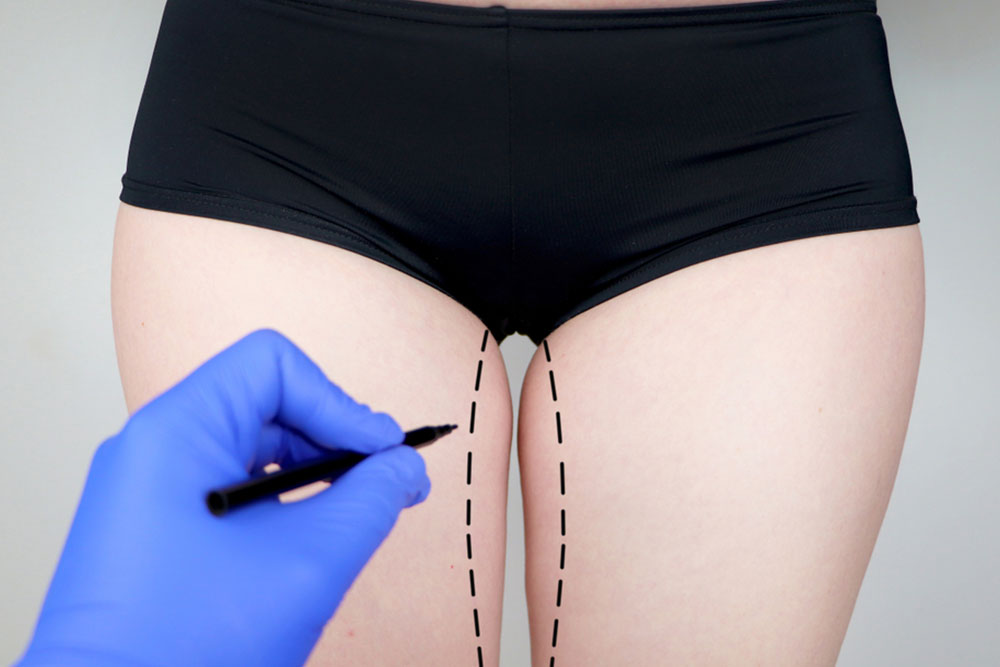Picture this: you’ve just committed to a thigh lift, the popular cosmetic surgery that’ll have your legs looking as toned as a seasoned marathon runner’s. You’re pumped, but you can’t help but wonder about the thigh lift recovery time and the nitty-gritty details surrounding recovery from a thigh lift. We get it; you want to jump back into your normal routine, looking better than ever. But first, let’s dive into what recovery entails and how to manage it.

What is Thigh Lift Surgery and When is it Needed?
Also known as thighplasty, this surgical procedure removes excess fat and skin from the thighs to improve skin elasticity and body contour. This type of thigh lift procedure is particularly beneficial for those who have experienced weight loss and are carrying loose skin that exercise and diet cannot resolve. It is one of many types of thigh lift procedures such as the mini thigh lift, medial thigh lift, spiral thigh lift, or outer thigh lift which is selected based on each individual’s needs and goals.
What to Expect Immediately After Surgery
Post-surgery, you’ll likely experience moderate pain, which can be managed with oral pain medications. You’ll also be dressed in compression garments to help with swelling and promote healing.
First Few Hours After Surgery
In the first few hours after surgery, you’ll be monitored for any signs of complications like excessive bleeding or fluid accumulation. The surgical incision will be carefully inspected, and you might have drains placed to remove excess fluids.
Recovery Timeline
Every person’s thigh lift recovery time varies, but typically, patients are advised to refrain from strenuous activities for several weeks.
Week 1: Baby Steps and Follow-Ups
The first week is like getting used to a new pair of shoes; it’s uncomfortable but necessary for breaking them in. Walking will still be a bit awkward but less painful. A follow-up appointment is usually scheduled within the first week to evaluate healing, remove drains, and potentially update your pain medication.
Week 2: Light at the End of the Tunnel
By the end of the second week, you’ll start to feel a bit more like your old self—well, your old self with potentially fabulous legs. You’ll have another follow-up appointment around this time to ensure everything is healing as it should. Light activities, like walking without wincing, can usually be resumed.
Week 3-4: Entering the Safe Zone
At this point, you might feel like a butterfly emerging from its cocoon. Swelling will significantly reduce, and you can start introducing light exercise into your routine. Compression garments are still advised to assist in the healing process.
Week 6 and Beyond: The New Normal
By the sixth week, most people can resume normal activities, although heavy lifting and strenuous exercises are still off-limits. Your doctor will probably schedule another follow-up appointment to give you the green light for a more active lifestyle.
Up to 6 Months: The Final Reveal
You’ll start noticing significant changes, but complete healing and the “final reveal” of your toned thighs might take up to six months. You’ll continue to have follow-up appointments during this period to monitor your progress.
Understanding this timeline can help you manage expectations and prepare adequately for each stage, making the overall experience less intimidating. Remember, recovery is a marathon, not a sprint, so give yourself the time to heal and enjoy the new you.
Tips for a Smooth Thigh Lift Recovery:
1. Watch Your Body Movement
Excess movement, especially in the upper thigh area, can delay your healing and potentially lead to complications like blood clots or deep vein thrombosis. It might seem counterintuitive, but the right amount of body movement can actually aid blood circulation, reducing the risk of clotting. Listen to your health care providers; they know what they’re talking about!
2. Be Mindful of Incision Sites
During the first couple of weeks post-surgery, the incision sites will be your most sensitive areas. Be sure to follow your aftercare plan meticulously. Neglecting this can not only elongate your average thigh lift recovery time but also compromise the natural healing process.
3. Don’t Skip on Gentle Exercise
The term ‘vigorous exercise’ should be on your taboo list for at least six weeks post-surgery. However, gentle exercise is beneficial for blood circulation and can actually speed up your healing time. Of course, always consult with your healthcare providers before hitting the yoga mat.
4. Eating Right for Recovery
You are what you eat, and after a thigh lift, you want to be a medley of nutrients that promote healing tissues and minimize excess swelling. Think of preparing healthy meals as a different form of pain management.
5. Blood Thinner and Deep Vein Thrombosis
The term ‘deep vein thrombosis’ might sound like something straight out of a medical drama, but it’s a real concern. Some healthcare providers might recommend a blood thinner as a preventative measure. Keep this in mind as you work through your recovery plan.
6. Swelling Be Gone!
Excess skin and swelling are typical in the first few weeks. While it might be uncomfortable, know that this is a normal part of the healing process. Compression garments can help here, but make sure not to make them too tight as it could inhibit blood circulation.
When Can You Expect Final Results?
When it comes to the final results of a thigh lift, you’re essentially playing the long game. The initial results will be visible almost immediately—yes, you’ll see less saggy skin and a more toned appearance. However, it’s crucial to remember that the initial aftermath includes swelling and incision marks, which can cloud the complete “after” picture you’re eagerly awaiting. Compression garments will be your best friend during this time, helping to reduce swelling and assist the healing process.

Full recovery and the awaited moment of seeing your transformed thighs may take up to six months, sometimes even a year, depending on your body’s healing capacity and skin elasticity. The scars from the thigh lift, although permanent, will fade significantly over time and are usually well-hidden in natural groin creases or the inner thigh area. Following your surgeon’s post-operative care instructions to the letter can expedite this process, leading you to your final, impressive results sooner rather than later.
Why Choose Dr. Casey Holmes?
Having an experienced plastic surgeon like Dr. Casey Holmes ensures that you’re in the right hands for both the thigh lift and the crucial recovery phase.
In closing, understanding the thigh lift recovery process is essential to ensure a smooth transition back to your daily life. So, if you’re serious about getting a thigh lift, schedule a consultation with Dr. Casey Holmes to discuss your options, and expectations, and to start your journey toward the legs you’ve always wanted.